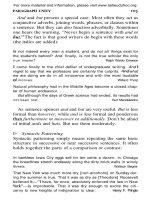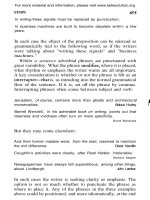Essential guide to writing part 28
Bạn đang xem bản rút gọn của tài liệu. Xem và tải ngay bản đầy đủ của tài liệu tại đây (283.64 KB, 15 trang )
PUNCTUATION
course, the letters). Contractions are common in speech and
are permissible in informal writing, though they should be
avoided in a formal style. They are most likely with auxiliary
verbs and negative words, and in all cases an apostrophe
should be placed in the position of the deleted sound or letter:
He'll go. = He will go.
We would've gone. = We would have gone.
They won't go. They will not go.
Notice that in the last example several sounds have
dropped, but only one apostrophe is used.
The contracted form of the auxiliary have, incidentally,
sounds exactly like the unstressed of. Because of this confu-
sion such constructions as / could of gone are sometimes seen.
That is not in accordance with formal usage and should be
avoided. The proper form is: / could've gone.
The Apostrophe to Mark Elision
Elision is dropping a sound from a word. This often occurs
in rapid speech going) and was sometimes done in
older poetry (e'en for even, ne'er for never), though rarely in
modern verse. An apostrophe signals when a sound is elided.
Elision is rarely necessary in composition.
The Apostrophe with the Plural Forms of
Letters
When letters and numerals are used in the plural, they gen-
erally simply add
Learn your ABCs.
The were a period of great change.
There are, however, three exceptions: (1) capital letters in
abbreviations with periods, (2) capital letters that might look
For more material and information, please visit www.tailieuduhoc.org
THE OTHER MARKS
confusing with a simple -s plural, and (3) lowercase letters
used as nouns:
The university graduated twenty M.A.'s.
He makes his A's in an unusual way.
Mind your p's and q's.
The Quotation Mark
Quotation marks are used with (1) direct quotations, (2) cer-
tain titles, and (3) words given a special sense. Quote marks
have two forms: double ") and single ('...'). Most
American writers prefer double quotes, switching to single
should they need to mark a quote within a quote. British
writers are more likely to begin with single quotes, switching,
if necessary, to double. Whether single or double, the quote
at the beginning is called an opening quotation mark; the one
at the end, a closing.
Quotation Marks with Direct Quotations
A direct quotation consists of the words actually spoken or
written by someone other than the writer. It is distinct from
an indirect quotation, which reports the substance of what
was said or written but changes the words to fit the
often altering pronouns and verbs:
DIRECT She said, "We are not going."
INDIRECT She said that they were not going.
Direct quotations must be signaled by quote marks; indi-
rect quotations must not be.
Introducing a Quotation
In introducing a quotation the subject and verb of address
may precede, follow, or intrude into the quoted matter. The
three possibilities are punctuated like this:
For more material and information, please visit www.tailieuduhoc.org
PUNCTUATION
She said, "We are not going."
"We are not going," she said.
"We," she said, "are not going."
Notice that the first word of the quotation is capitalized,
but that when a quotation is in the third exam-
opening word of the continuation is not capitalized
(unless, of course, it happens to be a proper noun or adjective
or the beginning word of a new sentence).
Written quotations may be preceded by a comma, or, more
formally, by a colon:
Professor Brown writes: "By themselves statistics are rarely enough;
they require careful interpretation."
Often written quotations are worked into the text in a
smoother manner by an introductory that. The that requires
no stop since it turns the quotation into a noun clause acting
as the direct object of the verb; and the first word of the
quotation is not capitalized:
Professor Jones writes that "by themselves statistics are rarely
enough; they require careful interpretation."
If a quotation is extensive and involves more than one par-
agraph, it is customary to repeat the opening quote marks at
the beginning of each new paragraph. Closing quotes are used
only at the end of the final paragraph.
However, extended written quotations are more com-
monly indented, in which case quote marks are not needed.
Quotation Marks in Relation to Stops
With opening quote marks, a comma, a colon, or any other
stop always precedes the quotation mark.
With closing quotes, however, the matter is more compli-
cated. In American usage, commas and periods always come
inside a final quote mark; semicolons and colons, outside.
For more material and information, please visit www.tailieuduhoc.org
THE OTHER MARKS
This rule applies regardless of whether the stop in question is
part of the quotation or not:
She said, "We are not going."
She said, "We are not going," and they didn't.
She said, "We are not going"; they didn't.
She said, "We are not going": why, wonder?
In the case of question marks and exclamation points,
placement depends on whether the stop applies only to the
quotation, only to the sentence containing the quotation, or
to both. When the quotation is a question (or exclamation)
and the enclosing sentence is a declarative statement, the
query (or exclamation point) comes inside the final quote
mark:
She asked, "Are we going?"
When the quotation is a statement and the enclosing sen-
tence a question, the query is placed outside:
Did she say, "We are going"?
When, finally, both quotation and sentence are questions,
the query is inside the quote mark, where it does double duty:
Did she ask, "Are we going?"
Notice that whether it goes inside or outside the closing
quotation, the query (or exclamation point) serves as the end
stop; no period is necessary.
> Quotation Marks with Titles
Some titles of literary works are italicized (in typescript, un-
derlined), others are placed in quote marks. The basic consid-
eration is whether the work was published or presented
For more material and information, please visit www.tailieuduhoc.org
PUNCTUATION
separately or rather as part of something larger (for example,
a magazine or collection). In the case the title is italicized;
in the second, set within quotes. In practical terms, this means
that the titles of books, plays, and long poems, such as the
are italicized, while the titles of short stories, short po-
ems, essays, articles in magazines or other periodicals, and the
titles of chapters or sections within a book are quoted:
Hemingway's novel A Farewell to Arms has been made into a
movie.
A Winter's Tale is one of Shakespeare's so-called problem
comedies.
"A Rose for Emily" by William Faulkner is a shocking short story.
In Vanity Fair Thackeray calls one chapter "How to Live on Nothing
a Year."
The finest carpe diem poem in English is Andrew Marvell's "To His
Coy Mistress."
The titles of movies are italicized, those of television and
radio shows are quoted:
Robin and Marian is an unusual and interesting film treatment of
the Robin Hood story.
"Truth or Consequences" was popular both on radio and on
television.
Notice that the first word of a title is always capitalized.
So are the last word and all intervening words except articles
(a, an, the), short prepositions, and coordinating
conjunctions.
Quotation Marks to Signify Special Meaning
Limited or Technical Meaning
Sometimes a common word must be used in a special sense
that applies only within a limited context. To make the lim-
itation clear, it helps to put the word in quotes:
For more material and information, please visit www.tailieuduhoc.org
THE OTHER MARKS
Some years later Eton became the first public in
the sense that students were accepted from everywhere, not merely
from the neighborhood. Morris Bishop
Irony
Irony is using a word in a sense very different
opposite conventional meaning. Effective irony de-
pends on the reader's recognizing the writer's intent. Inten-
tion should be clear from the context. Even so, a signal is
sometimes advisable. In speech this is given by intonation, as
when we speak the word brave in a scornful way to mean
"cowardly." In writing, the signal may be supplied by quo-
tation marks:
The Indians were therefore pushed back behind ever-retreating
frontiers. "Permanent" boundaries were established between the
United States and the Indians, tribes were moved out of the United
States and established beyond those boundaries. Again and again
the boundaries were violated by the whites.
James Oliver Robertson
Citation Terms
A citation term is a word used to refer to itself rather than to
the object or concept or feeling it conventionally designates.
Usually such terms are italicized, but sometimes they are
quoted. (They should never be treated both ways.) The fol-
lowing pair of sentences illustrate the difference between the
same word used first in its conventional sense and second as
a citation term:
A horse grazed in the meadow.
"Horse" is a citation term.
Definitions
When a word is defined, its meaning is sometimes put in
quotes, the word itself being italicized:
For more material and information, please visit www.tailieuduhoc.org









